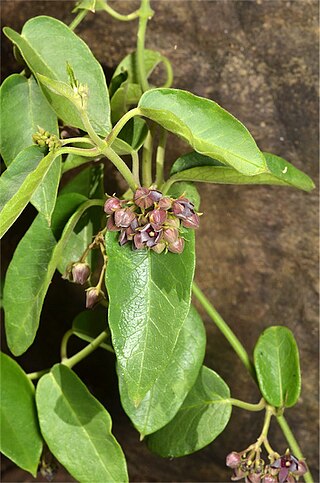Swallowwort or swallow-wort is a common name for several plants and plant families. The term may be a description of poisonous effects, or indicate that a plant was formerly used medicinally for tonsillitis.

Vincetoxicum rossicum is a flowering plant in the family Apocynaceae. It is a perennial herb native to southern Europe and is a highly invasive plant growing in all of the Eastern United States, in the mid west, and southern Ontario and Quebec in Canada. It has several common names including swallowwort, pale swallowwort, and dog-strangling vine; though it does not actually strangle dogs, it can “strangle” native plants and small trees if it is in dense patches. There has historically been much confusion about the genus it belongs to, with authors placing it within Vincetoxicum and others within Cynanchum, but recent molecular and chemical analyses have shown it to belong in the genus Vincetoxicum.
Vincetoxicum shaanxiense is a species of plant in the family Apocynaceae, first described in 1905. It is endemic to China, known from Gansu and Shaanxi Provinces.
Tylophora is a former genus of climbing plants or vines, first described as a genus in 1810. The genus was originally erected by Robert Brown for four species he described in Australia. It was synonymized with Vincetoxicum in 2018, a decision accepted by Plants of the World Online as of February 2023.

Vincetoxicum is a genus of plants in the family Apocynaceae. Although the species in Vincetoxicum have sometimes been included in Cynanchum, chemical and molecular evidence shows that Vincetoxicum is more closely related to Tylophora, now included in Vincetoxicum. The generic name means "poison-beater" in Botanical Latin because of the plants' supposed antidotal effects against snakebite.

Vincetoxicum hirundinaria, commonly named white swallow-wort, is a long-lived herbaceous perennial of the genus Vincetoxicum in the family Apocynaceae.

Vincetoxicum nigrum, a species in the family Apocynaceae, also known as black swallow-wort, Louise's swallow-wort, or black dog-strangling vine, is a species of plant that is native to Europe and is found primarily in Italy, France, Portugal, and Spain. It is an invasive plant species in the northeastern United States, parts of the Midwest, southeastern Canada, and California. In 2020, wild plants were found in Timaru, New Zealand.

Vincetoxicum barbatum, synonym Tylophora barbata, the bearded tylophora, is a small vine in the dogbane family. A common plant found south of Bulahdelah, New South Wales. The habitat is rainforest and moist eucalyptus forests in south eastern Australia. Not often seen in flower, but flowers are dark red, around 7 mm long on thin stalks. Broken branches produce watery or milky sap.
Cynanchum elegans, the white-flowered wax plant, is a plant species in the genus Cynanchum found in New South Wales in Australia. It is a threatened species.

Vincetoxicum polyanthum, commonly known as coast tylophora, is a vine in the dogbane family Apocynaceae first described in 1891 by the German botanist Otto Kuntze. It is native to the Australian states of New South Wales, the Northern Territory, and Queensland. In the Australian Tropical Rainforest Plants identification key, it is still treated as Tylophora benthamii.

Hypena opulenta is a moth in the family Erebidae. The species was first described by Hugo Theodor Christoph in 1877. Its reported native range expands from Eastern Europe Ukraine and Russia, south to Afghanistan, Iran, and Syria. In 2013, the moth larva was approved for release in North America to act as a biocontrol agent for invasive swallow-wort plants, Vincetoxicum rossicum and Vincetoxicum nigrum.
Vincetoxicum oblongum is a species of plants in the family Apocynaceae, native from west tropical Africa to south-west Ethiopia. Its synonyms include Oncostemma cuspidatum, at one time placed as the only species in the genus Oncostemma.
Pentatropis is a genus of plants in the family Apocynaceae, first described as a genus in 1834. It is native to Africa and southern Asia.

Vincetoxicum woollsii is a small vine in the family Apocynaceae, belonging to the genus Vincetoxicum. It is a rare plant found in New South Wales and Queensland. It was declared endangered by the Nature Conservation Act of 1992.
Vincetoxicum lineare is a species of plant in the family Apocynaceae native to Australia. Known as the bush bean, it is an edible species of plant found in arid regions. As Rhyncharrhena linearis, the species was at one time the only species in the monotypic genus Rhyncharrhena.

Vincetoxicum bracteatum, synonyms including Tylophora pauciflora, is a species of climbing plant in the family Apocynaceae. It is commonly known as kiri aguna in Sri Lanka. It is edible and is used in traditional medicine. It was first described by Carl Peter Thunberg in 1821 as Cynanchum bracteatum.
Vincetoxicum rupicola is a species of plant in the dogbane family Apocynaceae that is endemic to Queensland, Australia. It was first described by Paul Irwin Forster in 1992 as Tylophora rupicola.
Vincetoxicum forsteri is a species of plant in the dogbane family Apocynaceaethat is endemic to Australia. It was first described by Paul Irwin Forster in 1992 as Tylophora linearis.
Vincetoxicum cameroonicum is a species of flowering plant in the family Apocynaceae, native from Benin to Uganda in tropical Africa. It was first described by N. E. Brown in 1895 as Tylophora cameroonica.
Vincetoxicum anomalum is a species of flowering plant in the family Apocynaceae, native to the island of Bioko and Cameroon in the west of Africa, and from Uganda to KwaZulu-Natal and the island of Mayotte in the east of Africa. It was first described by N. E. Brown in 1908 as Tylophora anomala.








